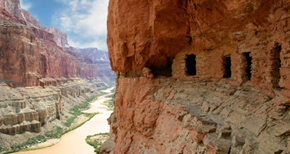Archaeology is the study of the ancient and recent human past through material remains. Archaeologists might study the million-year-old fossils of our earliest human ancestors in Africa. Or they might study 20th-century buildings in present-day New York City. Archaeology analyzes the physical remains of the past in pursuit of a broad and comprehensive understanding of human culture.
Types of Archaeology
Archaeology is a diverse field of study. Most archaeologists focus on a particular region of the world or a specific topic of study. Specialization allows an archaeologist to develop expertise on a particular issue. Some archaeologists study human remains (bioarchaeology), animals (zooarchaeology), ancient plants (paleoethnobotany), stone tools (lithics), etc. Some archaeologists specialize in technologies that find, map, or analyze archaeological sites. Underwater archaeologists study the remains of human activity that lie beneath the surface of water or on coasts. Cultural Resource Management, known as "CRM," refers to the work archaeologists do to follow federal and state laws.
Around the world, archaeological methods are similar. But archaeology in the Americas is a subfield of anthropology—the study of humans. In other parts of the world, archaeology is an independent field of study or part of historical research.
Archaeological Sites
An archaeological site is any place where there are physical remains of past human activities. There are many types of archaeological sites. Prehistoric archaeological sites are those without a written record. They may include villages or cities, stone quarries, rock art, ancient cemeteries, campsites, and megalithic stone monuments. A site can be as small as a pile of chipped stone tools left by a prehistoric hunter. Or a site can be as large and complex as the prehistoric settlements of Chaco Canyon in the American southwest. Historical archaeology sites are those where archaeologists can use writing to aid their research. Those could include densely populated modern cities, or areas far below the surface of a river, or the sea. The wide variety of historical archaeological sites include shipwrecks, battlefields, slave quarters, cemeteries, mills, and factories.
Artifacts, Features, and Ecofacts
Even the smallest archaeological site may contain a wealth of important information. Artifacts are objects made, modified, or used by humans. Archaeologists analyze artifacts to learn about the people who made and used them. Non-portable artifacts called features are also important sources of information at archaeological sites. Features include things like soil stains that show where storage pits, structures, or fences once existed. Ecofacts are natural remains related to human activity. Plant and animal remains can help archaeologists understand diet and subsistence patterns.
Context
Context in archaeology refers to the relationship that artifacts have to each other and to their surroundings. Every artifact found on an archaeological site has a defined location. Archaeologists record the exact spot where they find an artifact before removing it from that location. In the 1920s, archaeologists found a stone spear point lodged between the ribs of a species of a North American bison that went extinct at the end of the last Ice Age. It settled an argument that had gone on for decades. The spear point established once and for all that people had inhabited North America since the late Pleistocene. It is the context or association between the bison skeleton and the artifact that proved this. When people remove an artifact without recording its precise location, we lose that context forever. At that point, the artifact has little or no scientific value. Context is what allows archaeologists to understand the relationships between artifacts and between archaeological sites. It is how we understand how people in the past lived their daily lives.
Do Archaeologists Study Dinosaurs?
In short, no. Scientists who study dinosaur bones (or fossils) are paleontologists. Paleontology is the study of the history of life on Earth as based on fossils. That includes dinosaurs, other ancient animals, plants, and even bacteria. Paleontologists have a lot in common with archaeologists. Both excavate and study physical remains. The key difference is that archaeologists study the human past. Some archaeologists study animals or plants too, looking at the relationships that people had with them in the past.
The last of the dinosaurs died out about 65 million years ago. Our earliest hominid (human-like) ancestors didn’t arise until about 5 million years ago. So, people and dinosaurs never lived on our planet at the same time! This image of a geological clock helps put the timeline of the Earth into perspective. Dinosaur fossils help paleontologists study the history of life on earth. But dinosaur bones aren’t necessarily helpful to archaeologists, who want to understand human history, unless the bones were used by humans in some way.
Paleontologists, archaeologists, and other scientists such as geologists, chemists, and biologists often work together to better understand ancient environments. For example, research teams at Olduvai Gorge in Tanzania are made up of archaeologists, paleontologists, and more. Olduvai Gorge is home to some of the earliest hominid fossils.


